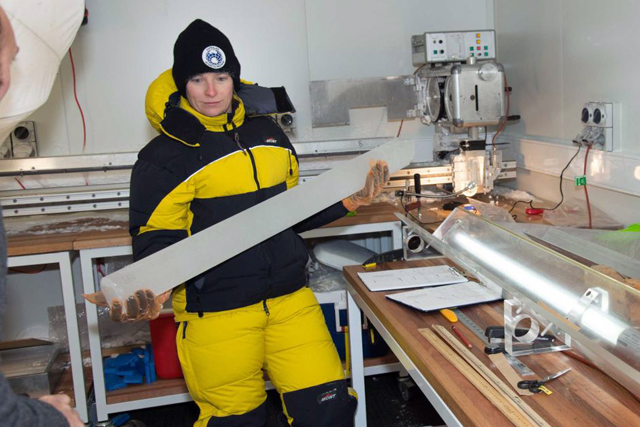Scientists are continuing to wrestle with the ramifications of climate change, but who’s listening?

ACE-CRC glaciologist Tessa Vance holds a drill core of Antarctic ice. As she told the symposium, ancient Antarctic ice has much to tell us about Australia’s evolving climate. PHOTO ABC
In times when government support for science is generally declining, every opposite step, no matter how small, is welcome news indeed.
Last week, just after I’d castigated him over his performance in the environment portfolio, newly-appointed science minister Greg Hunt announced that he’d directed CSIRO to make climate science a core activity and to create 15 new climate research jobs.
It was a reassuringly positive sign from the new minister, and a breath of fresh air in the very rank atmosphere created by CSIRO chief Larry Marshall’s decision six months ago to abandon most research into climate change and focus on technical “solutions”.
But it came too late to save some CSIRO careers cut short by Marshall’s decision. World-leading sea level expert John Church, who had 38 years with the organisation, is among casualties.
Church has work options elsewhere, but it should never have come to this. Back in February the previous minister, Christopher Pyne, could have immediately directed Marshall not to axe climate jobs. Why didn’t he? Did he not have the ticker? Was he silenced by Coalition colleagues?
As Church reminded me last week, clarifying the complexities of climate change requires many disciplines and institutions to come together and share resources, and successful climate research demands continuity – crucial factors that Marshall’s disruptive plans ignored.
Church was one of around 150 scientists who came together in Hobart for the biennial Antarctic Climate and Ecosystems CRC symposium discussing current and future research in the Antarctic and Southern Ocean and showcasing the work of emerging Antarctic scientists.
The symposium marked 25 years since the Hawke government established the first Antarctic CRC (for “cooperative research centre”) as a partnership between CSIRO, the Bureau of Meteorology, the Australian Antarctic Division and the University of Tasmania.
The secret of this CRC’s success has been in drawing these separate institutions together, providing the strength in numbers that has driven Hobart’s emergence as a major global climate research hub.
If this year’s CSIRO disruptions can be overcome there’s much to be optimistic about in Australia’s climate science capacity. Last week’s symposium attested to a healthy research community in presentations and posters covering a wide array of climate subjects.
A strong indication that the CRC formula continues to work here is overturning circulation, to use an oceanographic term. Presentations from different generations of scientists, recently-graduated to nearly-retired, showed how a wide range of ages in a workforce benefits everyone.
The symposium reached out to non-scientific expertise. Papers by military strategist David Millar, Climate Investment Group CEO Emma Herd, senior public servant John Whittington and fire chief officer Chris Arnol explored impacts of climate change on the wider community.
Senior CSIRO scientist Steve Rintoul spelled out the big scientific questions arising out of the Paris summit: What do the 1.5C and 2C targets mean? What are the tipping points, and how will things change in coming years and decades? Can we remove greenhouse gases from the atmosphere?
It was good to see Tasmanian environment minister Matthew Groom involved at the opening, but duty called him away before he could hear from Rintoul and others. It’s always disconcerting to see how little our political representatives are exposed to these crucial messages about our future.
The challenges laid out at the ACE-CRC meeting were amplified in the 2015 State of the Climate report released last week by the US National Oceanographic and Atmospheric Administration, authored by over 400 climate scientists including 19 Australians.
Last year’s multiple broken records included highest global mean surface temperature, warmest upper ocean, highest average sea level and lowest extent of Arctic sea ice.
Climate records are being broken so often these days that they’re in danger of losing their impact. All advocates of stronger action – scientists and non-scientists – need to find new ways to express their concern.
“The heat IS on” is the name of a Festival of Bright Ideas public forum on Saturday (Princes Wharf Shed, Hobart, 1 pm). Experts from science, local government, the law and public health will discuss what’s happening to our climate – and what needs to happen.
